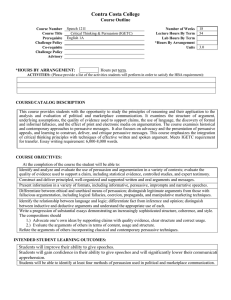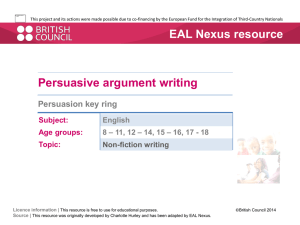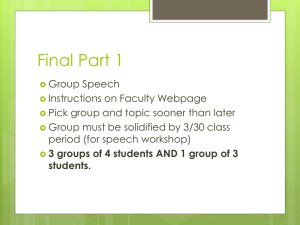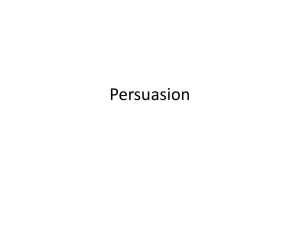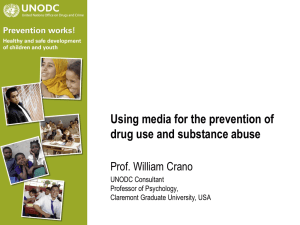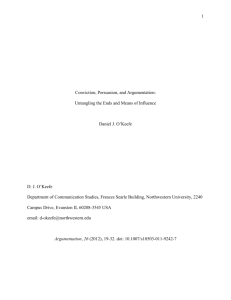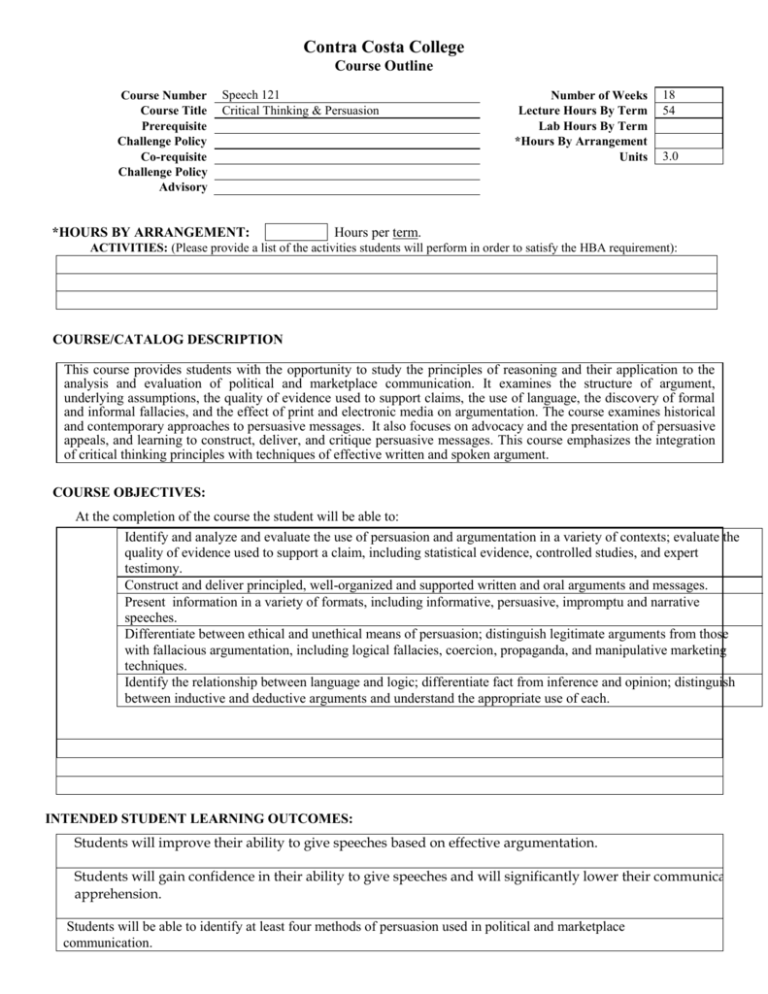
Contra Costa College
Course Outline
Course Number
Course Title
Prerequisite
Challenge Policy
Co-requisite
Challenge Policy
Advisory
Speech 121
Critical Thinking & Persuasion
*HOURS BY ARRANGEMENT:
Number of Weeks
Lecture Hours By Term
Lab Hours By Term
*Hours By Arrangement
Units
18
54
3.0
Hours per term.
ACTIVITIES: (Please provide a list of the activities students will perform in order to satisfy the HBA requirement):
COURSE/CATALOG DESCRIPTION
This course provides students with the opportunity to study the principles of reasoning and their application to the
analysis and evaluation of political and marketplace communication. It examines the structure of argument,
underlying assumptions, the quality of evidence used to support claims, the use of language, the discovery of formal
and informal fallacies, and the effect of print and electronic media on argumentation. The course examines historical
and contemporary approaches to persuasive messages. It also focuses on advocacy and the presentation of persuasive
appeals, and learning to construct, deliver, and critique persuasive messages. This course emphasizes the integration
of critical thinking principles with techniques of effective written and spoken argument.
COURSE OBJECTIVES:
At the completion of the course the student will be able to:
Identify and analyze and evaluate the use of persuasion and argumentation in a variety of contexts; evaluate the
quality of evidence used to support a claim, including statistical evidence, controlled studies, and expert
testimony.
Construct and deliver principled, well-organized and supported written and oral arguments and messages.
Present information in a variety of formats, including informative, persuasive, impromptu and narrative
speeches.
Differentiate between ethical and unethical means of persuasion; distinguish legitimate arguments from those
with fallacious argumentation, including logical fallacies, coercion, propaganda, and manipulative marketing
techniques.
Identify the relationship between language and logic; differentiate fact from inference and opinion; distinguish
between inductive and deductive arguments and understand the appropriate use of each.
INTENDED STUDENT LEARNING OUTCOMES:
Students will improve their ability to give speeches based on effective argumentation.
Students will gain confidence in their ability to give speeches and will significantly lower their communication
apprehension.
Students will be able to identify at least four methods of persuasion used in political and marketplace
communication.
COURSE CONTENT (Lecture):
Classical and contemporary theories of persuasion and argumentation; understanding structures of argument
Classical and contemporary message design and composition towards advocacy, including Aristotle’s canons of rhetoric, frame
of reference/attitude formation and change, Toulmin’s model, Monroe’s motivated sequence, and other relevant theories of
persuasion.
Perspectives on the importance of understanding values and ethics in argumentation; techniques for employing fair-mindedness
and empathy for a variety of viewpoints on issues
Understanding and evaluating the quality of evidence used to support a claim, including statistical evidence, controlled studies,
expert testimony
Deductive and inductive reasoning.
Critical thinking and analysis of marketing and print and electronic media, including classical and emerging techniques of
persuasion such as eye-tracking, neuro-marketing, product placement, and social media
Study of reasoning errors and logical fallacies
The effect of language on perception and persuasion
Persuasive Speaking to a live audience, emphasizing the importance of research and delivery in clarifying content.
COURSE CONTENT (Lab):
METHODS OF INSTRUCTION:
Individual speech preparation and presentation
Lectures and class and group discussions
Observation and critique of speeches, trial testimony, political and marketing campaigns and other persuasive events,
including media
Readings in text and on contemporary political and social issues
Group work and competition on discovery of fallacious reasoning
Review of quizzes and exams
INSTRUCTIONAL MATERIALS:
NOTE: To be UC/CSU transferable, the text must be dated within the last 7 years OR a statement of justification for a text beyond the
last 7 years must be included.
Textbook Title:
Author:
Publisher:
Edition/Date:
Textbook Reading Level:
Justification Statement:
Becoming a Critical Thinker
Sherry Diestler
Pearson/Prentice-Hall
6th edition 2011
12th Grade
(For textbook beyond 7 years)
Lab Manual Title (if applicable):
Author:
Publisher:
Edition/Date:
OUTSIDE OF CLASS WEEKLY ASSIGNMENTS:
Title 5, section 55002.5 establishes that a range of 48-54 hours of lecture, study, or lab work is required for one unit of credit.
For each hour of lecture, students should be required to spend an additional two hours of study outside of class to earn one
unit of credit.
Title 5, section 55002(a) 2F establishes coursework should call “for critical thinking and the understanding and application of
concepts determined by the curriculum committee to be at college level.”
For degree applicable courses: List one example of critical thinking out-of-class assignments
Outside of Class Weekly Assignments
Hours per week
Weekly Reading Assignments (Include detailed assignment below, if applicable)
2
Read the articles on the Structure of Argument in Chapter 1 and Ethics in Argumentation in Chapter 2. Be able to
discuss the difference between issues of fact, value, and policy.
Weekly Writing Assignments (Include detailed assignment below, if applicable)
2
Construct an opinion statement on a controversial issue, such as the issues discussed in Chapter 1 and 2, detailing the
issue, your conclusion, and reasons that support your conclusion.
Weekly Math Problems (Include detailed assignment below, if applicable)
Lab or Software Application Assignments (Include detailed assignment below, if applicable)
Other Performance Assignments (Include detailed assignment below, if applicable)
2
Present your opinion statement to the class and be prepared to clarify your reasoning.
STUDENT EVALUATION: (Show percentage breakdown for evaluation instruments)
Title 5, section 55002 (a) 2A requires that the grade be based on demonstrated proficiency in subject matter.
For degree applicable courses: Course requires essay writing, or, in courses where the curriculum committee deems
appropriate, problem solving exercises, or skills demonstrations by students.
Title 5, section 55002(a) 2F requires that coursework call for critical thinking and the understanding and application of concepts
determined by the curriculum committee to be at college level.
For degree applicable courses: List (an) example(s) of methods of evaluation that assess critical thinking.
%
Essay
%
Computation or Non-computational Problem Solving Skills
%
Skills Demonstration
Create a persuasive speech on a controversial issue using at least three sources of credible research to support your
argument. Use ‘both-sides persuasion’ to demonstrate understanding of opposing arguments.
%
%
%
%
Objective Examinations
Distinguish inductive from deductive reasoning, quality support from unreliable support, logical
fallacies from reasonable arguments; understand the uses of manipulation in media, e.g.
neuromarketing, doublespeak, and framing.
Other (describe)
Debates and group discussion on controversial issues
GRADING POLICY: (Choose LG, P/NP, or SC)
Letter Grade
90% - 100% = A
80% - 89% = B
70% - 79% = C
60% - 69% = D
Below 60% = F
Pass / No Pass
70% and above = Pass
Below 70% = No Pass
Prepared by: Sherry Diestler
Date: 2/17/2015
Revised form 08/14
X
Student Choice
90% - 100% = A
80% - 89% = B
70% - 79% = C
60% - 69% = D
Below 60% = F
or
70% and above = Pass
Below 70% = No Pass

